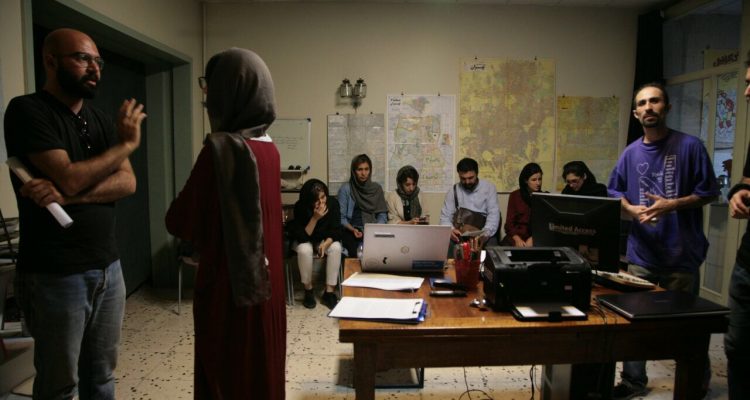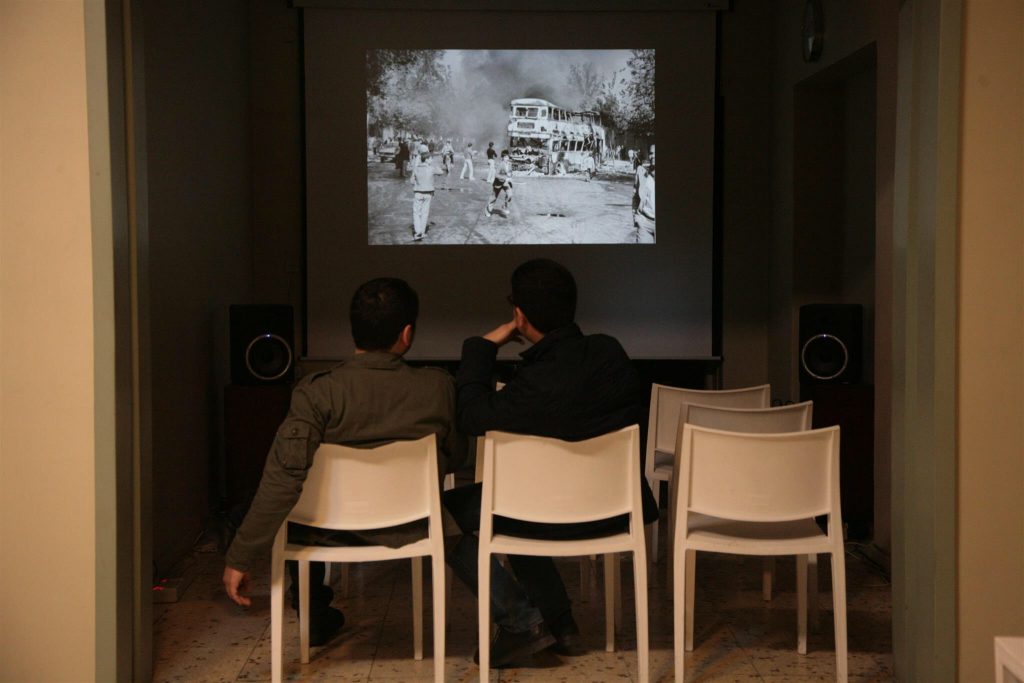 Installation Shot, “Mapping Karimkhan”, 2017, courtesy of New Media Society 2
Installation Shot, “Mapping Karimkhan”, 2017, courtesy of New Media Society 2
“Imagine being stuck in the midst of a massive storm taking everything with its way. Then there’s me and a handful of other people working here, as if clenching to the last standing tree,” This is how in a friendly conversation one of the leading art-publishers of Iran described the current state of the country’s art institutes. He continued, laughing, “little do we know, the swirling mass uprooted the tree long time ago. We, the tree, and everything else are all just swirling up in the air.”
The image is both cynical and true. Such poetic—and dire—descriptions of the situation are what young Iranians have inherited from the generation that created the Islamic revolution of 1979. I am a Post-Revolution Iranian which means that I’m part of a generation that was born with a sense of failure stemming from decades of ideology and who came to adulthood traumatized by the downfall of our own civil rights movement—culminating in the ‘Green Movement’ and ‘Arab Spring’. Today we find ourselves scattered around the world and horrified by the global resurgence of populist nationalism. As an emerging artist, I wonder, “what can we do?”
Now, and for around two decades, a new generation of Iranian artists have asked, “How can we act and move beyond the specter of failure and cynicism?” To keep myself going, I think of New Media Society, an art collective at the heart of Tehran. New Media Society comes to mind because it has become important among artists, curators, historians, and enthusiasts engaged with the production of contemporary art in Iran. The function of this Tehran initiative, which was born from an impromptu gathering of young art producers is very straight forward. It can be viewed as a venue of sorts where publications are produced from whatever is available. Or it can be described as an open door for those who want to learn and those who would like to engage, experiment, and create in the context of this city. Here, by using simple means like Skype, lectures, screenings, and workshops take place in which international scholars, and old Iranian colleagues abroad, can return to the conversation. Perhaps New Media Society is a helping hand offered to actualize impossible, daring, urgent, and non-conformist projects. Or it’s a room to crash in and a place from which new comers make a start (artists from the country’s ‘peripheries’ coming to this ‘capital’, or from the foreign art ‘centers’ of the Globe to this ‘exotic’ destination). It is a center for artists who are determined to explore the everyday life of this odd metropolis. Or it is four walls dedicated to art works that refuse and are refused by white cube galleries. Infused by the old spirit of Avant-Gardes, New Media Society is an organic and ever changing community of young artists, makers, thinkers, and curators that are determined to “learn by doing.”

Installation Shot, “Wall Newspaper #1 | 79 Revolution”, 2017, courtesy of New Media Society
Out of context New Media Society might not seem particularly unique or new. But New Media Society is based on two simple principles that transform the classical art collective into a unique and urgent base for contemporary art in Tehran: New Media Society refuses to enter and engage with the art market. Their ethos is to dedicate themselves to the immediate reality of their surroundings instead of burning themselves out by trying to navigate and theorize the global art world.
New Media Society grew out of an old effort. It started in 1998 with the foundation of Parkingallery, an independent make-shift project space built by then-recent art graduates who soon became a new wave of exciting independent curators, artists, and researchers. The project began in response to the shortcomings of the country’s art institutions. These young art producers were actively objecting to, and moving beyond, three barriers: the limited opportunities offered by the universities, the dated discourses at the center of the museums, and the unbearable ignorance of the art market. So, out of a parking garage they created a space where projects could easily happen. Experimentation was encouraged, and new genres could be explored with vigor. In the summer of 2002, the Internet became their platform as they launched their online project parkingallery.com. Here they found a new way to converse beyond borders which surpassed the national political constraint without forfeiting their autonomy to the global art market and the handful of gallery owners who had access to the international scene. But much has changed in the past decade-and-a-half. Tehran is now overpopulated with new galleries, but they are designed to sell naïve art as commodities and entertainment to a new rising bourgeoisie. The early hopeful era when the Internet was thought to be an equalizing, accessible, and free platform has been replaced by a carefully designed web that runs on market value and political power. The art collective too has changed. Today, it has separated into two entities with different responsibilities, Parkingallery and New Media Society. Parkingallery has limited its energy and attention to international demands. However, in New Media Society, the members came together to delve into doing, making, criticizing, learning, and creating opportunities specifically in and for Tehran.
Amirali Ghasemi is a founding member of both Parkingallery and New Media Society—and the art director of sorts for both. I first met Amirali two years ago in the height of the Nuclear Deal crisis. Back then we spoke of the impossible pressure that had been placed upon the young curators and artists functioning internationally who were being contextualized through the country’s fetishized political controversies. Today, Amirali’s assessment of New Media Society is tied to the social status of a country that is newly encountering a global world—ushering in the vicious politics of the neoliberal economy. I realized that, when confronted with Amirali’s realities, my questions centered on ideology and verged on abstraction. I asked him about the limited diversity of their artist residency program and Iran’s complicated relationship with the Middle Eastern Art Scene at large. In both examples, Amirali went back to the brutal influence of geopolitics on funding, and hence on what is possible. He opened our conversation with a sobering confession: “our rent has suddenly doubled. This is what matters the most right now.” Regardless of my longing for simple utopian answers, New Media Society is not interested in replacing institutes or producing alternative historical narratives.

Installation Shot, “Mapping Karimkhan”, 2017, courtesy of New Media Society
Dadaist in character, the projects produced by New Media Society vanish with the attempt to describe them. Their focus is no longer limited to “New Media,” and the work moves from video to sound, installation, performance, archiving, and workshops, to simple gatherings. At the moment they are now examining the meaning of “Society.” In an ongoing project, “Wall newspaper #1 | 79 Revolution”, they created an interactive and continuously shifting wall-installation showcasing the oral history of the moment the revolution occurred, a moment that is now nearly forty years old. Their playful approach allows space for all the complicated, contrary, and urgent feelings that the subject unearths. In another recent expansive project, they took up their immediate surroundings. “Mapping Karimkhan” borrows its name from the neighborhood that New Media Society currently calls home. It is central to the city, in the heart of Tehran’s art scene, and currently faces a rapid and violent process of gentrification. The project aims to observe and understand its habitat. The exploration has taken many forms, from the neighborhood’s first open studios initiative, to lectures involving social scientists, to simple invitations for field research conducted on, with, and by local people.
The project is an ode to what was lost between the lines of history, the absurd spirit of hope that is both the cause and effect of action. The only way to understand this is to join in. One must ‘act’ with New Media Society. In preparing this article, I kept pressing Amirali to give me a rational narrative of the story of New Media Society, their beginning, their activities, and their goals. Exhausted, he summed it all up as “just a ladder for people to climb. Beyond that, People can go where they want with it.” And over the years that is what has happened. Many joined the commercial art world, others listened to the call of other countries. Members, collaborators, and guests alike have followed their own individual paths. “But we can’t all just leave the base and go up. Or it will fall apart. Here, we come together to hold the ladder.”
New Media Society is modest and perhaps keeps its expectation low purposefully. Yet it is a base that is stubbornly maintained and it exists not in spite of, but because of the uncertain reality that surrounds it. It is crucial to recognize the urgency and importance of what occurs between these four walls.